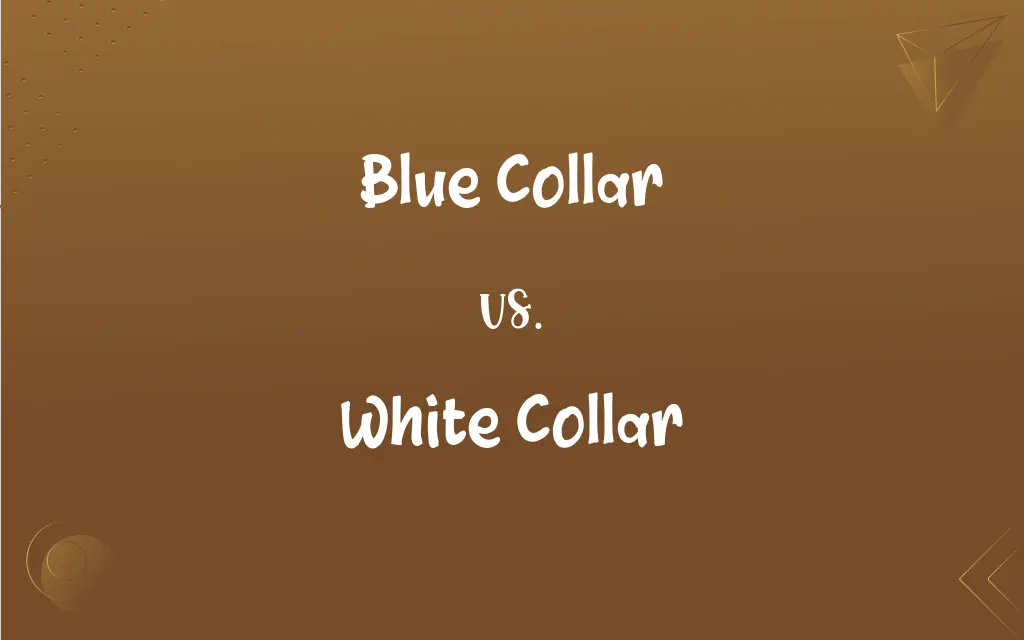Blue Collar vs. White Collar: What's the Difference?
Edited by Aimie Carlson || By Harlon Moss || Updated on October 13, 2023
Blue collar refers to manual or technical labor jobs, often involving physical work, while white collar refers to professional or managerial jobs, typically in an office setting.

Key Differences
Blue collar workers traditionally engage in hard manual labor, often related to manufacturing, construction, and maintenance. They perform tasks that may require specific technical skills and physical prowess, exemplifying the hands-on nature of their work. Meanwhile, white collar workers generally occupy positions in offices, executing administrative, managerial, or professional tasks that mainly involve mental or interpersonal skills. Here, the distinction predominantly aligns with the working environment and nature of tasks.
Historically, blue collar work was named for the durable blue uniforms or shirts worn by individuals in these professions, which could handle dirt and grime without obvious staining. On the contrary, white collar work was designated as such due to the crisp, white, button-down shirts typically adorned by professionals in an office, symbolizing a cleaner, less physically demanding work environment. Thus, the clothing not only differentiated the roles but also metaphorically symbolized the contrast in their working conditions.
In societal and economic contexts, blue collar workers may be viewed as the backbone of industries that demand manual proficiency, producing tangible goods or providing essential services. Conversely, white collar workers are often perceived as those steering the administrative, financial, and planning aspects of businesses, focusing on strategy, management, and organizational activities. Both segments are crucial, fulfilling distinct but interconnected roles within the economic ecosystem.
Blue collar roles might include mechanics, factory workers, and construction workers, where the outcome of labor is visibly tangible or physically observable. On the other side, white collar roles such as accountants, consultants, and IT specialists, might produce intangible outputs like strategies, data analyses, or software, crucial for organizational functioning but not physically manifested.
A noteworthy aspect is that blue collar jobs may not necessarily require advanced educational degrees, although technical proficiency and vocational training are often essential. In contrast, white collar jobs usually demand higher educational qualifications, sometimes specific degrees or certifications, in relevance to the specialized nature of the role, making educational prerequisites a distinguishing factor.
ADVERTISEMENT
Comparison Chart
Nature of Work
Manual or technical labor
Administrative or professional
Typical Workwear
Durable, often blue uniforms
Clean, often white shirts
Working Environment
Factories, sites, workshops
Offices, board rooms
Educational Demand
May not require advanced degrees
Often requires advanced degrees
Output of Work
Tangible goods or services
Intangible services or strategies
ADVERTISEMENT
Blue Collar and White Collar Definitions
Blue Collar
Blue collar roles often produce tangible products or direct services.
Many blue collar workers were involved in constructing the new bridge.
White Collar
White collar relates to jobs in office settings, often involving managerial or professional tasks.
She aspires to secure a white collar job in a multinational corporation.
Blue Collar
It signifies employment in trade, manufacturing, or mechanical sectors.
The automotive industry employs numerous blue collar workers in its factories.
White Collar
It pertains to work that usually doesn’t involve manual labor and is often administrative in nature.
Data analysis is a common task in many white collar professions.
Blue Collar
Blue collar pertains to manual labor often involving physical exertion.
My father has been a blue collar worker in the shipyard for 30 years.
White Collar
White collar positions often correlate with corporate environments, focusing on strategy, planning, or oversight.
Her white collar position in finance involves comprehensive budget management.
Blue Collar
The term is often associated with workers who perform hands-on operations.
Blue collar tasks in agriculture involve direct engagement with crops and livestock.
White Collar
White collar denotes roles that usually demand a higher educational or professional qualification.
Lawyers and doctors typically fall under the white collar category.
Blue Collar
It may include vocations in construction, maintenance, and technical tasks.
Blue collar jobs in the electrical field often involve installation and repair work.
White Collar
White collar can refer to roles in sectors like finance, consulting, and IT, which involve non-physical work.
He works a white collar job in an IT firm, focusing on software development.
FAQs
Can blue collar jobs require specialized training?
Yes, many require specific technical skills or vocational training.
How did the term "blue collar" originate?
From the blue uniforms or shirts worn by workers, which could hide dirt and grime.
What is the origin of "white collar"?
From wearing white, button-down shirts which symbolized cleaner, office-based jobs.
Are white collar jobs always in offices?
Largely yes, they usually involve desk-bound, administrative, or managerial tasks.
Can blue collar workers have high-paying jobs?
Yes, some blue collar jobs, especially with specialized skills, can be well-paying.
Is job security similar in blue and white collar jobs?
It can vary widely based on the industry, role, and economic conditions.
Which industries commonly employ blue collar workers?
Manufacturing, construction, and maintenance industries, among others.
Has the gap between blue and white collar jobs changed?
Yes, evolving technologies and economic shifts continuously redefine these roles.
Do all white collar jobs demand university degrees?
Generally, but not always. Many require advanced degrees or certifications.
Are blue collar jobs essential for economies?
Absolutely, they support key industrial and service sectors.
Can white collar work be outsourced?
Yes, certain tasks, especially in IT and customer service, can be outsourced.
How does technology influence white collar positions?
It enables remote work, automates tasks, and often necessitates continual skill upgrading.
Are unions prevalent in blue collar industries?
Yes, unions are quite common and often actively engaged in blue collar sectors.
Can white collar employees form unions?
Yes, while less common, white collar workers can and do form unions.
Is blue collar work physically demanding?
Typically, yes. It often involves manual labor or technical tasks.
What sectors are associated with white collar workers?
Finance, IT, consulting, and administrative sectors, to name a few.
How has technology impacted blue collar jobs?
It has automated some roles but also created new technical positions.
Can blue collar skills transition into white collar roles?
Certainly, especially where technical expertise can transition into managerial or planning tasks.
Can a job be both blue collar and white collar?
Rarely straightforward, some roles might blend features of both.
Are all white collar workers in managerial positions?
No, white collar roles can range from junior administrative to senior managerial positions.
About Author
Written by
Harlon MossHarlon is a seasoned quality moderator and accomplished content writer for Difference Wiki. An alumnus of the prestigious University of California, he earned his degree in Computer Science. Leveraging his academic background, Harlon brings a meticulous and informed perspective to his work, ensuring content accuracy and excellence.
Edited by
Aimie CarlsonAimie Carlson, holding a master's degree in English literature, is a fervent English language enthusiast. She lends her writing talents to Difference Wiki, a prominent website that specializes in comparisons, offering readers insightful analyses that both captivate and inform.































































